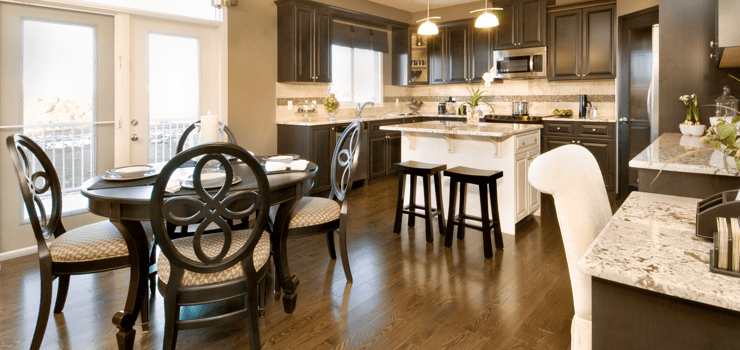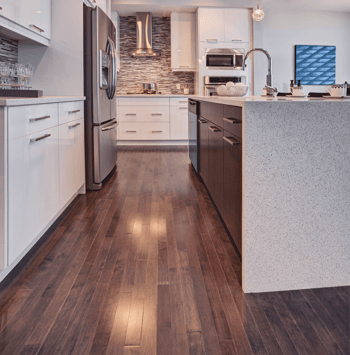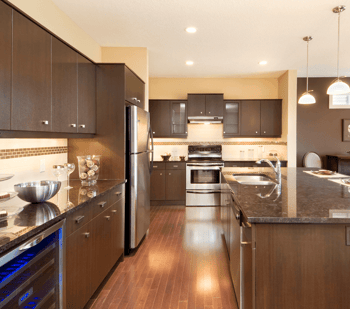 Cleaning a hardwood floor is more about its finish than its wood type. In fact, it really doesn't matter if your floor is made of oak, maple, mahogany, or an exotic overseas blend. It's the protective coating on top of the timber that you'll be cleaning, so that's what you need to worry about shining and preserving.
Cleaning a hardwood floor is more about its finish than its wood type. In fact, it really doesn't matter if your floor is made of oak, maple, mahogany, or an exotic overseas blend. It's the protective coating on top of the timber that you'll be cleaning, so that's what you need to worry about shining and preserving.
The good news is that hardwood floors can be sorted into three broad categories, depending on their type of finish. You don't need to be a lumberjack to understand them, either!
If you're looking to get wine stains, kid stains, or pet stains out of your hardwood, figure out which of these types best describes your floor.
 Surface-Sealed
Surface-Sealed
These hardwood floors are the sleek, glossy kinds that are smooth to the touch. You can't feel any grains when you run your fingers along them, and most are a light or medium-brown colour.
Surface-sealed hardwood floors have been treated with urethane, polyurethane, or polyacrylic to give them that shiny look. They're resistant to scratches and scuff marks, and they won't be damaged by everyday amounts of water. For all intents and purposes, they're laminate floors that just so happen to be made of wood.
As you might expect, surface-sealed hardwood floors are very easy to clean. You can sweep them and scrub them of spaghetti stains just like you would with any other surface, and you don't have to stress about the type of cleaning products you use. Dish washing soap is just fine!
Mopping isn't an issue either; as you'll read later in this article, mopping isn't advised for all types of hardwood floors, but surface-sealed ones have been pre-sealed against moisture. You won't want to use a sopping wet mop since it's still technically a wood product, but a damp mop is fine.
If you want to polish your surface-treated floor, it's important to use the right products to prevent damage and discolouration. Never use liquid wax or solid wax paste, and steer clear of all oil-based furniture sprays. Look for a water-based silicone polish that's safe to use on top of urethane.
To recap:
Sweeping and mopping are okay.
You can't hurt them with regular old soap and water, though you should stick to damp mops instead of very wet ones.
Use a water-based silicone polish.
Avoid waxes, oils, and furniture sprays.

Oil-Treated
Also known as "penetrating seal" floors, these hardwood floors can be identified by their rustic or natural look. Their individual planks are usually visible, and most will feel grainy to the touch. If you sprinkle a few drops of water on them, the moisture will sink into the wood and make a dark spot.
Oil-treated hardwood floors are common in houses made before the 1970's. They're also popular with homeowners who want a vintage look. Their finishes are made with waxes and oils that are soaked into the planks to form a protective barrier when they harden, so that's why they're also called "penetrating seal" floors. The wax and oil "penetrated" the wood to form a seal.
Since they're old school, oil-treated floors need more maintenance than the ultra-processed hardwood floors of today. The first thing to know is that you should never, ever mop them. The water will sink down into the floor, discolour the wood, and damage its protective oil coating.
Sweeping is your key line of defence with an oil-treated floor. Look for good stiff bristles that will catch everything in the floor's tiny grains. You can also vacuum.
As for polishing, you can use both solid and liquid wax with these kinds of hardwood floors, though the buffing is where the magic truly happens. Steer clear of acrylic or water-based waxes. Avoid furniture polish at all costs.
To recap:
Never use a wet mop on oil-treated floors.
Sweeping and vacuuming are okay.
Furniture polish is a big no-no.
Look for wax that isn't acrylic or water-based.
Miscellaneous
Some hardwood floors have been treated with varnish, lacquer, or shellac. Others haven't been treated at all, though this is rare in modern homes where kids and pets are expected to play.
These floors look pretty similar to oil-based ones. They're usually dark, rustic, and grainy with visible planks, and they might also be spotted with different shades of white and brown. Some might even be red depending on their age.
These floors function a lot like oil-based ones, too. They shouldn't be mopped or scrubbed with water, and if you need to polish them, look for very gentle products. Put most of your elbow grease into buffing instead of laying down artificial chemical mixes.
If you're not sure whether you're walking on an untreated or shellacked hardwood floor, perform a scratch test in an out-of-the-way area. Use a safety pin or the edge of a coin. If the wood flakes off when you scratch it, this is the kind of floor that you have.
To recap:
Avoid all forms of soap and water on an untreated hardwood floor.
Look for special polishes and cleaning products.
Sweep and vacuum as necessary.
Consider this your general guide to cleaning hardwood floors. As you can see, there's often a lot more to the process than just dropping some suds and putting your back into it, so take careful notes about the do's and don't's. You want your hardwood flooring to look vibrant and full-bodied, no matter what its type!





